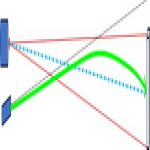I am confused guys regarding "bore line", and field of view.
Bore line:
The bullet never travels over the bore line (axis drawn to infinity for the pointing direction of the bore).
The bullet drops downwards forever from the bore line the instant it leaves the muzzle, never crosses it, and creates an arc falling below the bore line's axis until it hits the target, (hopefully at its zero'd height), which is in direct line with the optic's
line of sight. I know you guys know all this, I am just trying to clarify my understanding of the terms being used.
Did you mean the bullet's rise above the optic's line of sight? As you mentioned, this number will depend on how high the optic is mounted from the barrel's bore axis.
Absolute drop is the bullet's total drop due to gravity from the muzzle. Its a continuous increasing negative number downwards, negative from the muzzle axis. That same drop when calculated for the trajectory relative to the line of sight, is the same arc tilted upwards (as per the bore axis angle), which begins negative below line of sight, crosses line of sight, becomes positive above it, then drops to line of sight zero at the zero'd range.
Sketch below, (not to scale), for a high magnification BR scope (45 to 50x), which sees a few inches of target height at 50m, showing:

- black dashed line is the bore axis direction
- blue dot-dashed line is the line of sight from the center of the scope
- Red lines show the focused outer light beams reflecting off the target, focused into the center of the optic.
- Solid green line shows the bullet's trajectory, dropping continuously from the bore axis. But it rises above the line of sight, then drops to its zero'd point on target
Field of View:
In this high magnification scope example, the bullet starts below and outside the cone of light focused from the target. Therefore the bullet or trace cannot be visible for the first part of its flight.
I ran a quick scenario in JBM using a JBM library Lapua bullet, zero'd at 50m, 1.5 inch scope mount, MV 1085. It crossed elevation 0, i.e. the line of sight, at 15m from the muzzle. Due to the entry angle of the focused beam, it comes into the edge of the beam earlier than 15m, but its likely going to be impossible for the human eye to pick up at that entry point. The bullet needs time in flight inside the focused beam to generate enough movement image for your eye to pick it up. Roughly the first third of the bullet's flight is going to be invisible in this scenario because its below the focused line of sight cone
The lower the scope is mounted, the sooner the bullet can become visible for a given magnification.
As the scope power decreases, the field of view for where that bullet enters the focused beam should move towards the shooter, (again influenced by scope height), allowing more time for your eye to pick up the flight image. At a scenario of low scope magnification, almost the entire flight will be inside the line of sight focus beam due to the angles of focus into the center of the scope, e.g. a 9x magnification at 100m you can see almost the entire flight.
EDIT: There is a mistake in the sketch. See addendum edit post #37









































































